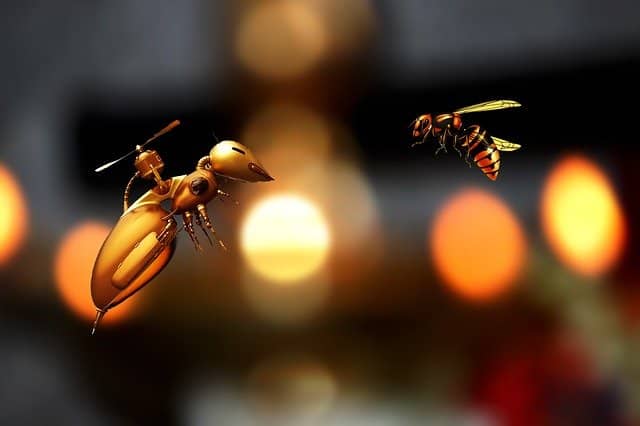ARTIFICIAL BEES FOR POLLINATION - They work like a REAL Swarm!

The first prototypes of robot bees for pollination, created by students and professors at Harvard University (Massachusetts, USA), were designed to resemble as closely as possible the structure, behavior and functionality of a real bee.
Robotic bees for pollination
The U.S. corporation Walmart patented a model of bee robots that are able to simulate pollination, being able to perform the job very efficiently.
It is worth mentioning that Walmart is a company dedicated to the food industry, which is investing in the creation of drones for this purpose, and already has six patented registrations. The best known is the black mirror robot bee.
The "Robo bee" is its original English name, besides being able to fly, due to its light weight and the shape of the structure of its legs, it can jump from the surface of the water.
They fly like an insect and are designed so that they can move very close to each other without colliding, simulating a real swarm of bees.
They have a flotation chamber that allows them to push their wings off the surface of the water.
Future models of these autonomous robots would be very useful for searching for people in the event of a natural disaster, as well as in warfare in reconnaissance and attack fronts, in areas with radioactivity, and many other fields.
Robotic Pollinator Bees - Solar Powered Honey Bees :

Companies Researching Robotic Pollination
- One of them is Biobest. The company has a stake in Arugga, an insect pollination technology company.
- The U.S. corporation Walmart
- Another group is the Wyss Institute. Researchers at the institute have developed innovative manufacturing techniques that greatly push the boundaries of robotic design. They are currently working on a RoboBee, which consists of a small microelectromechanical device. It is only one-tenth the size of a drone.
Importance of robot bees for pollination
In a parenthesis to remember: "Those who transport pollen are called pollination vectors. These vectors (biotic and abiotic agents). The biotic ones are mainly bees, bumblebees, butterflies, birds, bats, insects, among others. And also abiotic agents such as water and mainly wind."
Bees are the main biological agents that carry out pollination by transporting pollen from the stamens to the stigma of the flowers. The population of this species is one of the main indicators of the ecosystem for biologists.
Albert Einstein said: If bees were to disappear from the planet, mankind would have only four more years of existence.
What Albert Einstein said about bees is a good reference to realize that we are facing a very big problem in the near future.
The use of chemical products in the agricultural industry, such as pesticides and herbicides, has resulted in the death of bees. In addition, every year more and more hectares of land are used to meet the increasing demand of the population's consumption.
According to the Association of Beekeepers of the United States (AcuBiomed portal), 2012 was the worst year for beekeeping, due to a 50% decrease in the bee population, affecting crop production, which would endanger the global food supply.
To raise public awareness of their importance and education in educational centers, therefore May 20 has been given as the "International Day of the Bees".
This has resulted in the need for scientific research in universities and private companies to create these prototypes of mechanical bees.
View more:
